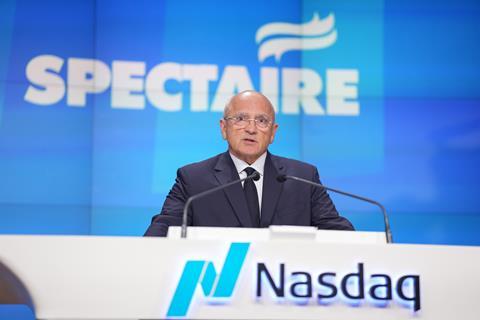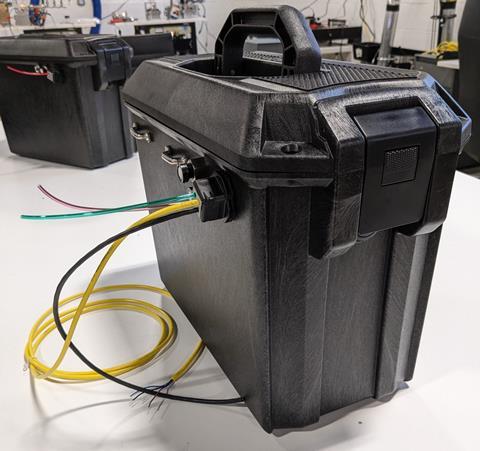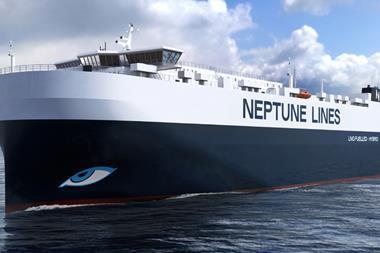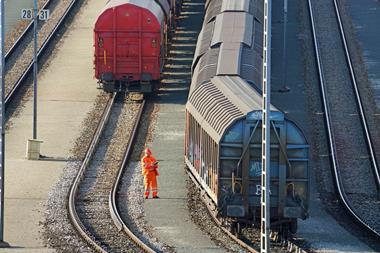For automotive logistics, there can be no accountability without accurate carbon accounting. We spoke to Brian Semkiw, CEO of Spectaire, about how micro-mass-spectrometry can solve an issue too-often evaded by the auto industry: accurate emissions measurements

According to CarbonCare calculations, the transport and logistics industry is currently responsible for approximately 24% of global carbon dioxide equivalent (CO2e) emissions, highlighting the pressing need for action to mitigate its severe environmental impact. But the challenge is not an easy one to solve, since the rate is not fixed. The European Environment Agency has projected that if substantial and effective reduction measures are not properly implemented, the global logistics sector will account for 40% of carbon emissions by 2050.
Recognising the severity of the problem, global sustainability and carbon emissions reduction projects are fast becoming foundational to the automotive logistics industry; propelled by demand pressures, increasing regulatory frameworks, and a growing corporate commitment to sweeping environmental action. But there is a serious problem at the heart of these efforts, and it all hangs on the lack of accurate carbon emissions measurements.
“The truth is, just because you have a truck which is rated at a certain emissions output, it doesn’t actually mean that it performs that way on the road”
This measurement problem may be the greatest challenge for the global carbon reductions project as the sheer complexity and dynamism of carbon emissions makes it extremely difficult to measure them with any reliability. And let’s not forget, ‘you cannot manage what you cannot measure’.
Micro-mass-spectrometry: solving the measurement problem with accurate carbon emissions data
At the centre of solving this critical measurement issue is Spectaire, whose CEO, Brian Semkiw, recently discussed the company’s important role in reforming emissions monitoring techniques with the company’s latest innovation, the Spectaire Aircore. The Aircore is a portable, and easily deployable micro-mass-spectrometer. Semkiw describes mass spectrometry, the science behind this product, as well established, “having been around for seventy years,” he says; but traditionally cumbersome and expensive.

“We’ve taken the capabilities of this huge, heavy - and inconveniently immoveable machine - which traditionally costs hundreds of thousands of dollars and stands at the size of a refrigerator - and reduced it down to a size that can fit in your hand - and at a cost that is easily accessible for the automotive logistics industry,” he explains.
As mass-spectrometers lose their ‘mass’, this miniaturisation represents no less than industry accessibility. Mass-spectrometers operate by analysing gas at the molecular level, thereby offering precise insights into exact atmospheric compositions. During the Volkswagen scandal, it was a mass spectrometer that was instrumental in scrutinising the air samples, and revealing discrepancies in official emissions claims.
According to Semkiw, Spectaire’s mass-spectrometer miniaturisation has virtually disrupted the carbon emissions measurement space because the technology drives not just CO2 recording accuracy, but does so by positively adding high-value yield to the accurate emissions measurement conundrum; and so may have the potential to solve the carbon measurement problem across the board. “And by harnessing exhaust gases, we conduct readings at 53-second intervals, ensuring the real-time monitoring of emissions.”
Seeing the order in the chaos: capturing accurate emissions data readings
The Aircore’s ability to provide real-time emissions data is significant when you realise the highly dynamic and consequently unpredictable variables that impact vehicle emissions ‘in via’, (on the road), and in real-time. For automotive logistics, this means that a single vehicle’s emissions output fluctuates with such high variability across the supply chain, that attempts to provide accurate readings as to their actual carbon footprints have so far proved highly problematic.
Utilising laboratory-based mass spectrometry for emission assessments (the current industry standard) is, for this reason, inherently flawed. “Generally overlooked variables such as maintenance practices, filtration systems, fluid compositions (and even the manipulable activation status of mitigation technologies), have a significant impact on emission profiles,” Semkiw says.
“The truth is, just because you have a truck which is rated at a certain emissions output, it doesn’t actually mean that it performs that way on the road.”
Real-time measurements and real-time regulations
For vehicle logistics, portable, real-time mass-spectrometry has the potential to provide the accuracy demanded by serious sustainability efforts. This carbon innovation is timely, presenting an important and much-needed sustainability solution as the automotive industry grapples with the Paris Climate Agreement’s objectives (aiming for reductions of 45% by 2030 and net zero by 2050), and broader regulatory pressures concerning reporting standards such as those proposed by the US Securities and Exchange Commission toward net-zero.
“We have a way to actually derive profit from the steps that a company is taking in reducing its emissions”
- Brian Semkiw, CEO of Spectaire
Semkiw marks this regulatory impetus as a clear catalyst in spurring Spectaire’s technological development. As governments tighten regulations, companies such as Spectaire are stepping in to provide solutions that ensure compliance while - contrary to popular opinion - fostering economic advantages. But how?
The potential for accurate emissions measurements to transform liabilities into assets
There are also noteworthy financial implications associated with Spectaire’s micro-mass-spectrometry tech; perhaps its most compelling aspect because after all, automotive logistics is first and foremost a business. Behind closed-doors, companies are often operating under a near-visceral reluctance towards comprehensive reductions projects, borne out of long-held presumptions of associated negative financial implications. Put simply, companies believe carbon reduction projects are just too costly to implement in any meaningful way. But Semkiw says the Aircore not only reduces real carbon footprints, but that it turns this cost centre into an actual revenue stream.
“We have a way to actually derive profit from the steps that a company is taking in reducing its emissions,” he says.
Semkiw says the first financial benefit to be gained from this technology is the associated increase in business and enhanced competitiveness. Companies are increasingly in need of accurate emissions accounting across scope 3 (across their entire supply chains), “and those able to demonstrate accuracy and transparency will gain a fast and competitive advantage.” Companies will have the capability to command higher rates compared to their competitors. “McKinsey indicates that the vast majority of businesses are willing to pay more for sustainable fleet services, enabling them to generate more revenue,” he says.
Secondly, there’s a significant benefit in emissions management. “Similar to a doctor conducting a blood test to diagnose health issues, monitoring emissions serves as an early indicator of potential problems with the vehicle.” This proactive approach to maintenance prevents breakdowns and mitigates financial losses, ultimately reducing overall maintenance costs.

Lastly, Semkiw says he anticipates the potential of this technology to allow companies to earn carbon credits, which could be substantial. “A truck less than ten years old covering 100,000 annual miles could potentially earn up to $10,000 per year in carbon credits. This could have a significant impact, especially for vehicles involved in long-distance travel, such as big trucks.”
Given the slim profit margins in logistics companies, these additional revenue streams from increased business, higher rates and carbon credits are particularly valuable.
“The operational framework is straightforward,” says Semkiw. “Simply put, we install a proprietary device onto the vehicle, conduct emissions measurements, and juxtapose the findings against established environmental benchmarks. Discrepancies between actual emissions and regulatory standards present a monetisable differential, offering rapid returns on investment and facilitating data-driven business decisions.”
The World Economic Forum has emphased the need for innovations that can deliver granular, real-time data to drive decision-making in emissions management
This capability to “turn exhaust into money,” (that is - a liability into an asset), presents a new frontier where environmental responsibility aligns with profitability; a nexus that could really drive the widespread adoption of such technologies, whereas until now, the general attitude has been one of resistance.
The market and the carbon cost (and value) of micro-mass-spectrometry
The transport sector, as per the International Energy Agency, is responsible for nearly a quarter of direct CO2 emissions from fuel combustion, with road vehicles accounting for nearly three-quarters of transport CO2 emissions. The significance of accurate, real-time emissions monitoring cannot be understated, and Spectaire’s miniaturised mass spectrometer provides an answer to this exigency.
The World Economic Forum has also echoed this sentiment, emphasising the need for innovations that can deliver granular, real-time data to drive decision-making in emissions management.
In terms of market engagement, Spectaire is initially set on targeting the diesel engine industry (which make up the bulk of logistical vehicles), aiming especially at the segment comprising modern long-haul trucks in the US and Europe. However, Semkiw acknowledges the system’s versatility for broader applications, suggesting an eventual expansion to other engine types and fuel sources. “It can work on a truck that uses hydrogen or anything else,” he points out, indicating the technology’s widespread relevance.
The company’s pricing strategy, with units priced at approximately $2000, (or €2000 depending on business region), plus a $1000 (or €1000) annual fee for data analysis, positions the technology as an investment in sustainability with a tangible ROI. This fee, Semkiw assures, “translates complex emissions data into actionable insights, enabling fleet owners to make informed decisions and potentially capitalise on emissions trading markets.”
As the conversation around climate change intensifies, with the transportation sector being a significant contributor to global emissions, innovations like Spectaire’s are important technological advancements that represent a broader shift towards a more accurate, and carbon-accountable, automotive logistics industry.










































No comments yet